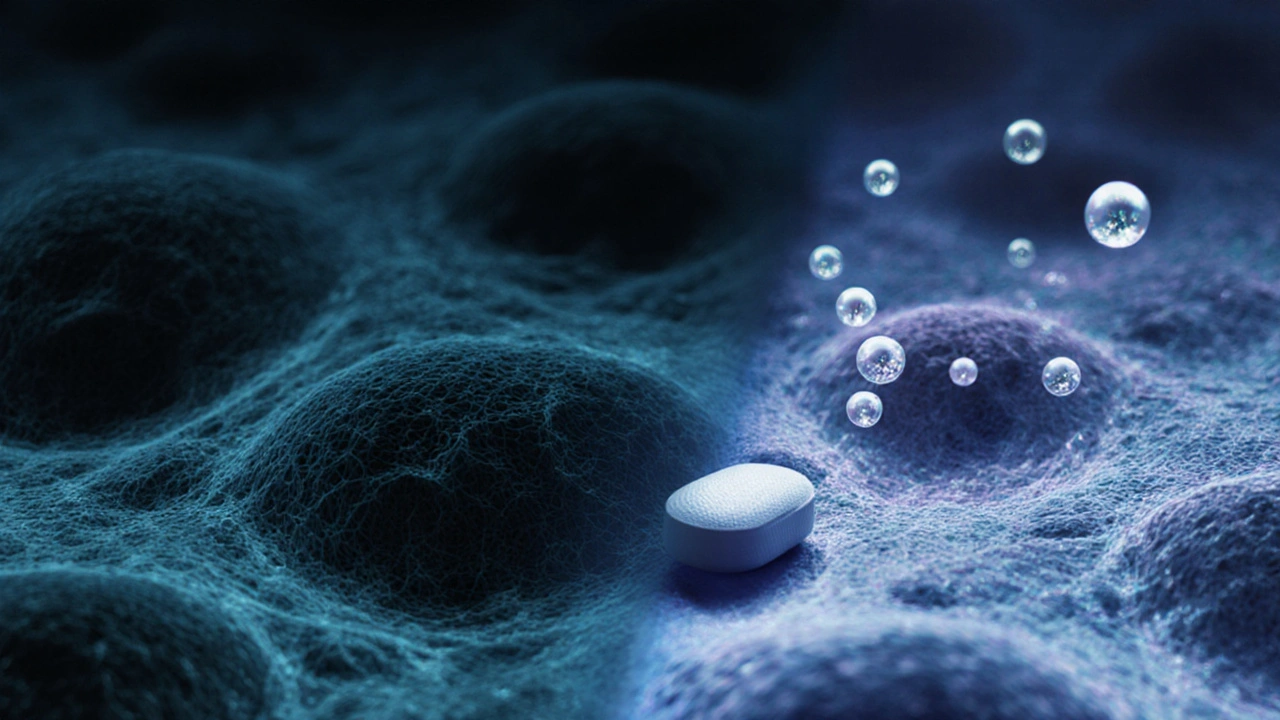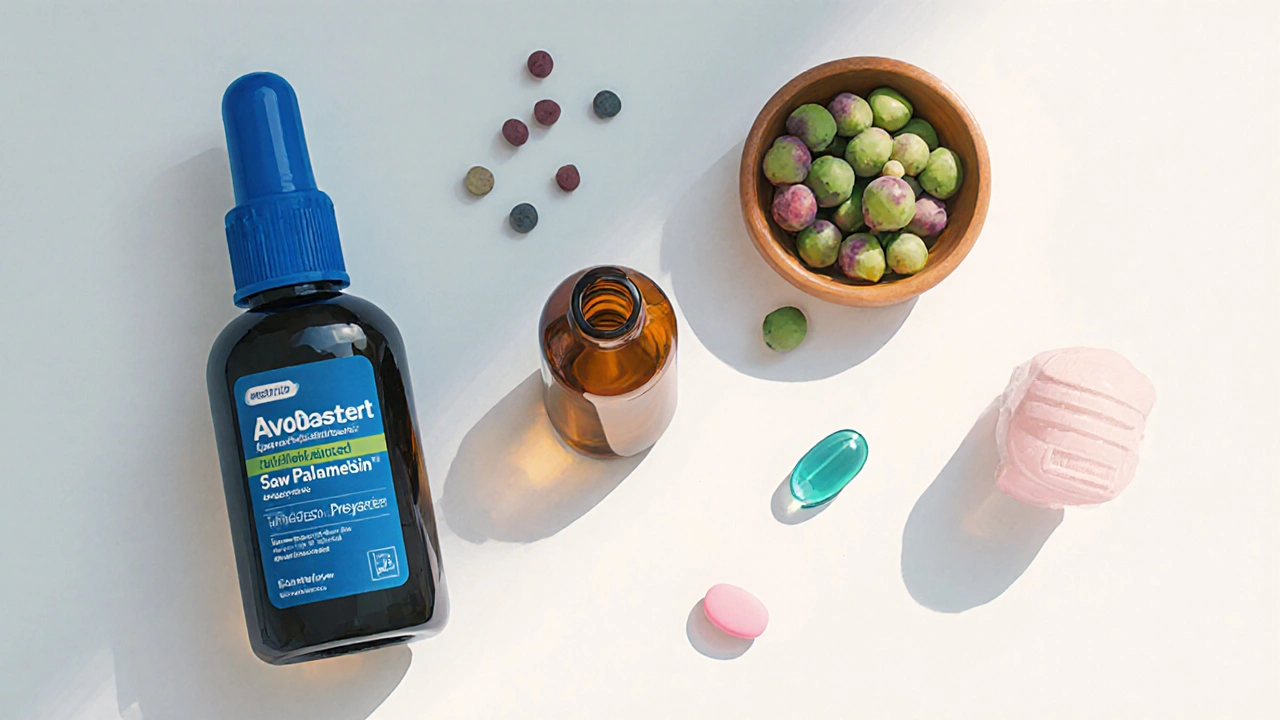Avodart (Dutasteride) vs Other BPH Treatments: Benefits, Risks & Alternatives

Oct, 7 2025
BPH Treatment Comparison Tool
Recommended Treatment Plan
Detailed Comparison
Key Takeaways
- Avodart (dutasteride) blocks both type‑1 and type‑2 5‑alpha‑reductase enzymes, making it the most potent DHT reducer for BPH.
- Finasteride targets only type‑2, offering similar relief for many men but with a slightly lower shrinkage rate.
- Herbal options like saw palmetto work far less predictably and lack robust clinical backing.
- Alpha‑blockers (tamsulosin, doxazosin) relax prostate muscle without shrinking size - useful for rapid symptom relief.
- Choosing the right therapy depends on prostate size, symptom severity, side‑effect tolerance, and cost considerations.
Why you’re reading this
If you’ve been prescribed Avodart for an enlarged prostate, you probably wonder whether there’s a better, cheaper, or safer option. This guide walks through how dutasteride works, who benefits most, and how it compares to the most common alternatives on the market today.
What is Avodart (Dutasteride)?
When treating benign prostatic hyperplasia (BPH), Avodart is the brand name for dutasteride, a 5‑alpha‑reductase inhibitor that lowers dihydrotestosterone (DHT) levels, causing the prostate to shrink over several months. The drug blocks both type‑1 and type‑2 isoenzymes, which is why it can reduce prostate volume by up to 30% in many patients. It’s taken as a 0.5mg tablet once daily, and the effects usually become noticeable after 3-6months of consistent use.
How dutasteride actually works
DHT is the hormone that drives prostate growth. By inhibiting the enzyme that converts testosterone to DHT, dutasteride cuts the hormone’s supply almost in half. This reduction leads to two key outcomes:
- Gradual shrinkage of the gland, which lessens urinary obstruction.
- Lower risk of acute urinary retention and the need for surgery.
Because it targets both isoforms, dutasteride tends to work faster and achieve greater size reduction than drugs that block only one isoform.

Top alternatives to consider
Below are the most frequently discussed BPH treatments, each with its own mechanism and typical use case.
Finasteride (Proscar)
Finasteride is another 5‑alpha‑reductase inhibitor, but it targets only the type‑2 enzyme. A daily 5mg dose can shrink the prostate by about 20‑25% over a year.
Saw Palmetto (herbal supplement)
Saw Palmetto is an extract from the berries of the Serenoa repens plant. Some men report modest symptom relief, yet large‑scale trials have shown mixed results, and the supplement lacks standard dosing.
Tamsulosin (Flomax) - Alpha‑blocker
Tamsulosin relaxes smooth muscle in the prostate and bladder neck, improving urine flow within days. It does not shrink the gland, so it’s best combined with a 5‑alpha‑reductase inhibitor for larger prostates.
Doxazosin - Another alpha‑blocker
Doxazosin works similarly to tamsulosin but can also lower blood pressure, which may be advantageous or problematic depending on a patient’s cardiovascular profile.
Side‑effect snapshot
Understanding potential adverse reactions helps you weigh pros and cons.
| Medication | Common Side Effects | Serious Risks |
|---|---|---|
| Avodart (dutasteride) | Decreased libido, ejaculatory volume, mild breast tenderness | Potential for high‑grade prostate cancer (monitor PSA closely) |
| Finasteride | Similar to dutasteride but slightly less frequent sexual changes | Same prostate‑cancer surveillance concerns |
| Saw Palmetto | Stomach upset, mild headache | Few reported serious events |
| Tamsulosin | Dizziness, abnormal ejaculation, retrograde ejaculation | Rarely, severe hypotension |
| Doxazosin | Fatigue, dizziness, nasal congestion | Significant blood‑pressure drops in sensitive patients |
Comparison table: Efficacy, Onset, and Cost
| Drug | Mechanism | Typical Onset (symptom relief) | Prostate Shrinkage % | Average Monthly Cost (US$) |
|---|---|---|---|---|
| Avodart (dutasteride) | 5‑alpha‑reductase inhibitor (type‑1 & 2) | 3-6 months | 25‑30% | 30‑45 |
| Finasteride | 5‑alpha‑reductase inhibitor (type‑2 only) | 4-9 months | 20‑25% | 20‑35 |
| Saw Palmetto | Herbal extract (unknown exact pathway) | Variable, often < 3 months | ~5‑10% (if any) | 15‑25 |
| Tamsulosin | Alpha‑blocker (muscle relaxation) | Days to weeks | 0% (no shrinkage) | 25‑40 |
| Doxazosin | Alpha‑blocker (blood‑pressure & muscle relaxant) | Days to weeks | 0% | 20‑35 |
How to decide which option fits you
Think of the decision as a flowchart. Ask yourself these core questions:
- How large is your prostate? If imaging shows a gland >40g, a 5‑alpha‑reductase inhibitor (dutasteride or finasteride) is usually recommended.
- Do you need rapid relief? Alpha‑blockers like tamsulosin provide symptom relief within days, making them ideal for acute urgency.
- Are sexual side effects a deal‑breaker? Both dutasteride and finasteride can lower libido; many men start with an alpha‑blocker and add a 5‑alpha‑reductase inhibitor later if needed.
- What’s your budget? Generic finasteride and tamsulosin are often cheaper than brand‑name Avodart, but insurance coverage varies.
- Do you have cardiovascular concerns? Choose tamsulosin over doxazosin if low blood pressure is an issue.
In practice, urologists frequently prescribe a combination of a 5‑alpha‑reductase inhibitor (for long‑term volume reduction) plus an alpha‑blocker (for quick symptom improvement). That combo works well for men with moderate‑to‑severe BPH.

Monitoring and follow‑up
Regardless of the drug you pick, regular PSA testing is essential. Dutasteride lowers PSA by about 50%, so your doctor will adjust the baseline to avoid missing signs of prostate cancer. Finasteride has a similar effect but slightly less pronounced.
Most clinicians schedule a repeat prostate exam and ultrasound at 6‑month intervals after starting therapy, checking for both symptom improvement and any adverse changes.
Insurance, pricing, and availability
Avodart is available as a branded tablet, though many insurance plans cover the generic dutasteride at a lower price. Finasteride is widely available as a cheap generic, often under $1 per 5mg tablet in the US.
Herbal supplements like saw palmetto are sold over‑the‑counter and can be purchased without a prescription, but the quality varies by manufacturer. Alpha‑blockers are prescription‑only, but generic versions keep costs manageable.
Bottom line
If you have a significantly enlarged prostate and can tolerate a gradual onset, Avodart offers the most potent DHT suppression and the highest average shrinkage. For men who need quicker relief or who are sensitive to sexual side effects, a combination of finasteride (or generic dutasteride) plus an alpha‑blocker often delivers the best balance.
Frequently Asked Questions
Can I switch from Avodart to finasteride?
Yes. Both drugs belong to the same class, so a doctor can transition you safely. Expect a slight dip in DHT reduction during the switch, so keep an eye on symptoms for a few weeks.
Do I need to take a PSA test while on dutasteride?
Absolutely. Dutasteride cuts PSA levels roughly in half, so your physician will double the reading to estimate the true value and monitor cancer risk.
Are there any natural alternatives that work as well as Avodart?
Current evidence suggests no herbal supplement matches the shrinkage achieved by dutasteride. Saw palmetto may help mild symptoms, but results are inconsistent.
What should I do if I experience sexual side effects?
Talk to your urologist. Sometimes lowering the dose or adding an alpha‑blocker can mitigate the issue. In many cases, side effects improve after the first few months.
Is it safe to use dutasteride if I’m planning to have children?
Dutasteride can affect sperm production and female fetal development. Men trying to conceive should discuss a wash‑out period (at least 6 months) with their doctor.
